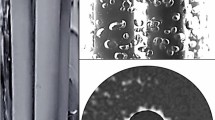Abstract
Objective
This study aimed to investigate the movement of liquid in the needle region of staked-in-needle pre-filled syringes using neutron imaging and synchrotron X-ray tomography. The objective was to gain insights into the dynamics of liquid presence and understand the factors contributing to needle clogging.
Methods
Staked-in-needle pre-filled syringes were examined using neutron radiography and synchrotron X-ray phase-contrast computed tomography. Neutron radiography provided a 2D visualization of liquid presence in the needle, while synchrotron X-ray tomography offered high-resolution 3D imaging to study detailed morphological features of the liquid.
Results
Neutron radiography revealed liquid presence in the needle region for as-received samples and after temperature and pressure cycling. Pressure cycling had a more pronounced effect on liquid formation. Synchrotron X-ray tomography confirmed the presence of liquid and revealed various morphologies, including droplets of different sizes, liquid segments blocking sections of the needle, and a thin layer covering the needle wall. Liquid presence was also observed between the steel needle and the glass barrel.
Conclusions
The combination of neutron imaging and synchrotron X-ray tomography provided valuable insights into the dynamics of liquid movement in staked-in-needle pre-filled syringes. Temperature and pressure cycling were found to contribute to additional liquid formation, with pressure changes playing a significant role. The detailed morphological analysis enhanced the understanding of microstructural arrangements within the needle. This research contributes to addressing the issue of needle clogging and can guide the development of strategies to improve pre-filled syringe performance.







Similar content being viewed by others
References
Wang SS, Yan Y (Susie), Ho K. US FDA-approved therapeutic antibodies with high-concentration formulation: summaries and perspectives. Antib Ther. 2021;4:262–72.
Sánchez-félix M, Burke M, Chen HH, Patterson C, Mittal S. Predicting bioavailability of monoclonal antibodies after subcutaneous administration : Open innovation challenge. Adv Drug Deliv Rev. 2020;167:66–77.
Garidel P, Kuhn AB, Schäfer LV, Karow-Zwick AR, Blech M. High-concentration protein formulations: How high is high? Eur J Pharm Biopharm. 2017;119:353–60. https://doi.org/10.1016/j.ejpb.2017.06.029.
Therapeutic Biological Establishment Evaluation Request (TB-EER) Form-Tocilizumab [Internet]. 2013. Available from: https://www.accessdata.fda.gov/drugsatfda_docs/nda/2013/125472Orig1s000OtherR.pdf.
Adamis Pharmaceuticals Corporation Issues Nationwide Voluntary Recall of SYMJEPI® (Epinephrine) Injection for Potential Manufacturing Defect [Internet]. 2022. Available from: https://www.fda.gov/safety/recalls-market-withdrawals-safety-alerts/adamis-pharmaceuticals-corporation-issues-nationwide-voluntary-recall-symjepir-epinephrine-injection.
De Bardi M, Müller R, Grünzweig C, Mannes D, Boillat P, Rigollet M, et al. On the needle clogging of staked-in-needle pre-filled syringes: Mechanism of liquid entering the needle and solidification process. Eur J Pharm Biopharm. 2018;128:272–81.
De Bardi M, Müller R, Grünzweig C, Mannes D, Rigollet M, Bamberg F, et al. Clogging in staked-in needle pre-filled syringes (SIN-PFS): Influence of water vapor transmission through the needle shield. Eur J Pharm Biopharm. 2018;127:104–11. https://doi.org/10.1016/j.ejpb.2018.02.016.
Fukuda M, Yamazaki T, Ueno S, Koga A, Yamanaka Y. European Journal of Pharmaceutics and Biopharmaceutics Viscosity increase / gelation of therapeutic IgG monoclonal antibodies induced by Zn 2 + : One possible root cause of clogging of staked-in-needle prefilled syringes. Eur J Pharm Biopharm. 2022;178:179–86. https://doi.org/10.1016/j.ejpb.2022.08.008.
Scheler S, Knappke S, Schulz M, Zuern A. Needle clogging of protein solutions in prefilled syringes: A two-stage process with various determinants. Eur J Pharm Biopharm [Internet]. 2022; Available from: https://doi.org/10.1016/j.ejpb.2022.05.009.
Kaestner A, Roth J, Grünzweig C. Real-time neutron imaging to detect origin of blocking in drug injection devices. PDA J Pharm Sci Technol. 2016;70:353–60.
Cloetens P, Barrett R, Baruchel J, Guigay JP, Schlenker M. Phase objects in synchrotron radiation hard x-ray imaging. J Phys D Appl Phys. 1996;29:133–46.
Kaestner AP, Hartmann S, Kühne G, Frei G, Grünzweig C, Josic L, et al. The ICON beamline A facility for cold neutron imaging at SINQ. Nucl Instruments Methods Phys Res Sect A Accel Spectrometers, Detect Assoc Equip. 2011;659:387–93.
Frei G, Lehmann EH, Mannes D, Boillat P. The neutron micro-tomography setup at PSI and its use for research purposes and engineering applications. Nucl Instruments Methods Phys Res Sect A Accel Spectrometers, Detect Assoc Equip. 2009;605:111–4.
D6653. Standard Test Methods for Determining the Effects of High Altitude on Packaging Systems by Vacuum Method 1. Annu B ASTM Stand. 2006;01:4–7.
**ng L, Li Y, Li T. Local Concentrating, Not Shear Stress, That May Lead to Possible Instability of Protein Molecules During Syringe Injection: A Fluid Dynamic Study with Two-Phase Flow Model. PDA J Pharm Sci Technol. 2019;73:260–75. https://doi.org/10.5731/pdajpst.2018.009357.
Acknowledgements
The authors would like to acknowledge Sun Qihang from Merck & Co., Inc. for the sample preparation.
Author information
Authors and Affiliations
Corresponding authors
Ethics declarations
Conflict of Interest
The authors declare there is no conflict of interest.
Additional information
Publisher's Note
Springer Nature remains neutral with regard to jurisdictional claims in published maps and institutional affiliations.
Supplementary Information
Below is the link to the electronic supplementary material.
Supplementary file2 (AVI 85664 KB)
Supplementary file3 (AVI 108046 KB)
Supplementary file4 (AVI 36609 KB)
Supplementary file5 (AVI 58082 KB)
Rights and permissions
Springer Nature or its licensor (e.g. a society or other partner) holds exclusive rights to this article under a publishing agreement with the author(s) or other rightsholder(s); author self-archiving of the accepted manuscript version of this article is solely governed by the terms of such publishing agreement and applicable law.
About this article
Cite this article
Hu, G., Bonanno, D., Su, Y. et al. Unraveling Pre-filled Syringe Needle Clogging: Exploring a Fresh Outlook Through Innovative Techniques. Pharm Res 41, 547–556 (2024). https://doi.org/10.1007/s11095-024-03673-7
Received:
Accepted:
Published:
Issue Date:
DOI: https://doi.org/10.1007/s11095-024-03673-7




